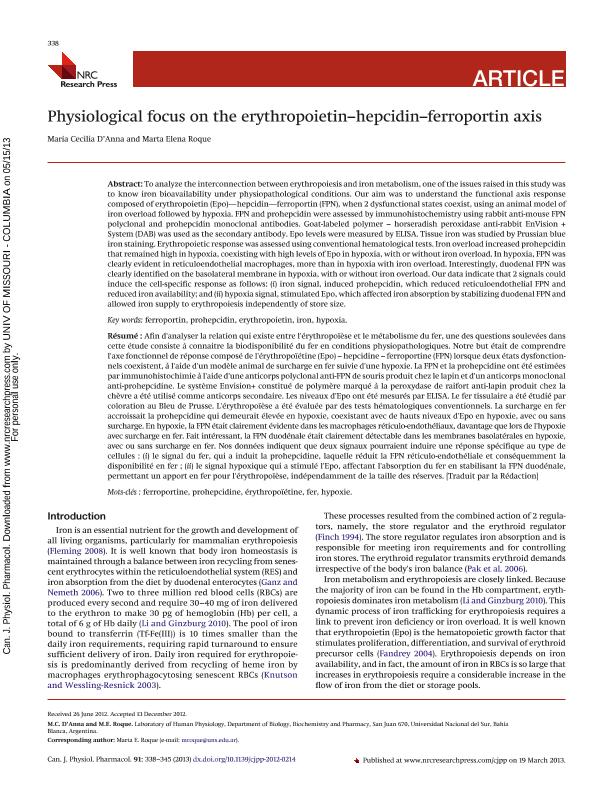Artículo
Physiological focus on the erythropoietin–hepcidin–ferroportin axis
Fecha de publicación:
05/2013
Editorial:
Natl Research Council Canada-n R C Research Press
Revista:
Canadian Journal Of Physiology And Pharmacology
ISSN:
0008-4212
e-ISSN:
1205-7541
Idioma:
Inglés
Tipo de recurso:
Artículo publicado
Clasificación temática:
Resumen
To analyze the interconnection between erythropoiesis and iron metabolism, one of the issues raised in this study was to know iron bioavailability under physiopathological conditions. Our aim was to understand the functional axis response composed of erythropoietin (Epo)—hepcidin—ferroportin (FPN), when 2 dysfunctional states coexist, using an animal model of iron overload followed by hypoxia. FPN and prohepcidin were assessed by immunohistochemistry using rabbit anti-mouse FPN polyclonal and prohepcidin monoclonal antibodies. Goat-labeled polymer − horseradish peroxidase anti-rabbit EnVision + System (DAB) was used as the secondary antibody. Epo levels were measured by ELISA. Tissue iron was studied by Prussian blue iron staining. Erythropoietic response was assessed using conventional hematological tests. Iron overload increased prohepcidin that remained high in hypoxia, coexisting with high levels of Epo in hypoxia, with or without iron overload. In hypoxia, FPN was clearly evident in reticuloendothelial macrophages, more than in hypoxia with iron overload. Interestingly, duodenal FPN was clearly identified on the basolateral membrane in hypoxia, with or without iron overload. Our data indicate that 2 signals could induce the cell-specific response as follows: (i) iron signal, induced prohepcidin, which reduced reticuloendothelial FPN and reduced iron availability; and (ii) hypoxia signal, stimulated Epo, which affected iron absorption by stabilizing duodenal FPN and allowed iron supply to erythropoiesis independently of store size.
Palabras clave:
Ferroportin
,
Prohepcidin
,
Erythropoietin
,
Iron
,
Hipoxia
Archivos asociados
Licencia
Identificadores
Colecciones
Articulos(CCT - BAHIA BLANCA)
Articulos de CTRO.CIENTIFICO TECNOL.CONICET - BAHIA BLANCA
Articulos de CTRO.CIENTIFICO TECNOL.CONICET - BAHIA BLANCA
Citación
D'anna, Maria Cecilia; Roque, Marta Elena ; Physiological focus on the erythropoietin–hepcidin–ferroportin axis; Natl Research Council Canada-n R C Research Press; Canadian Journal Of Physiology And Pharmacology; 91; 5; 5-2013; 338-345
Compartir




